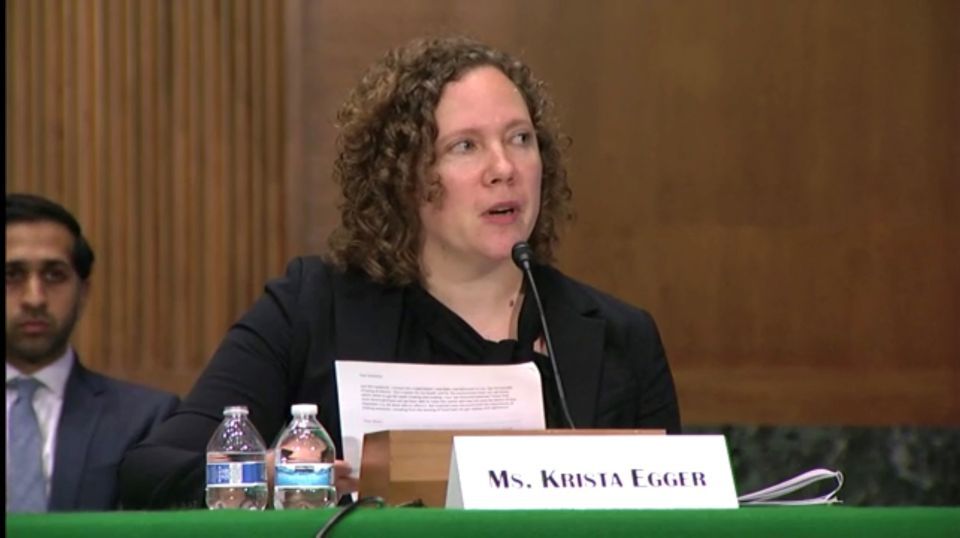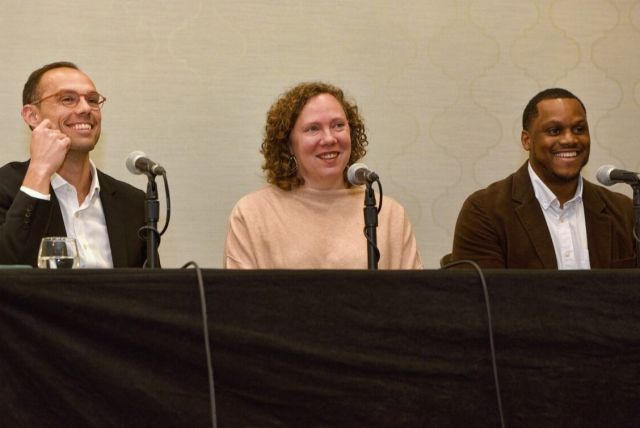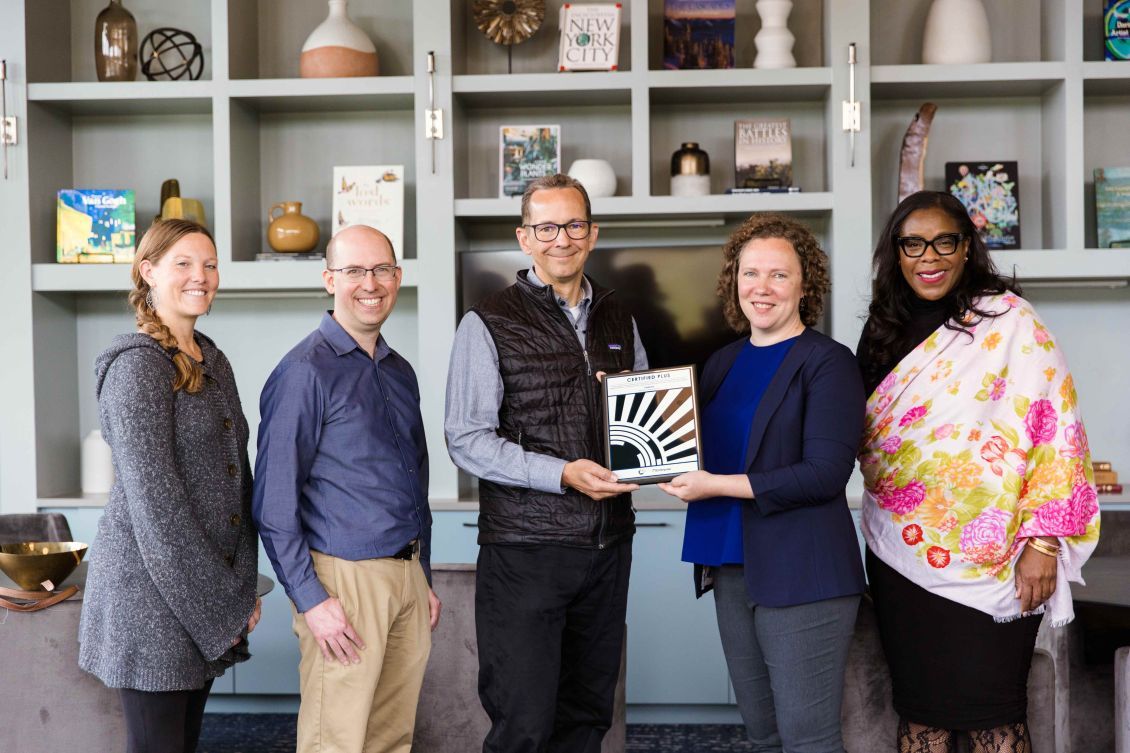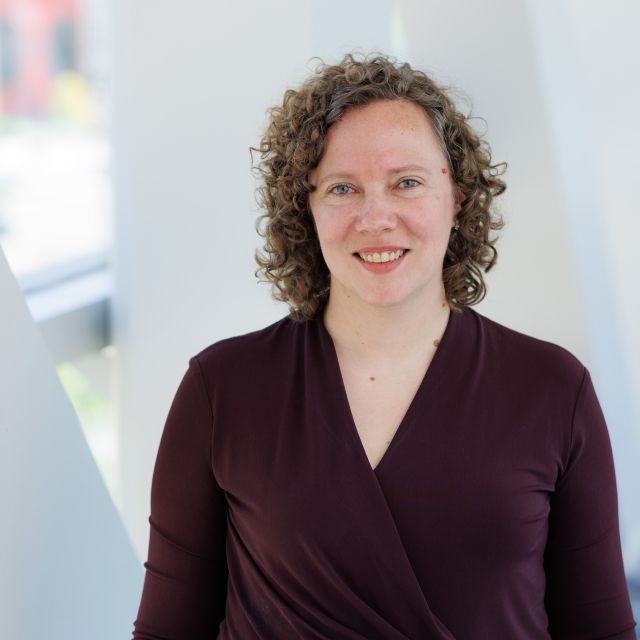Krista Egger has devoted her career to creating a healthier built environment. But her family roots are in agriculture. On her father’s side, Egger’s grandparents and generations before them were farmers and ranchers in West Texas. “I grew up with a strong understanding of our connection to the land. If it didn’t rain a whole lot during the season, we knew there would be fewer crops. It was clear how the health of the land directly contributed to the health of a family and a community,” she said.
Today Egger brings that sensibility to her work as vice president of Building Resilient Futures at Enterprise, where she leads a team that fights climate change and its consequences by advancing green building, resilience against natural disasters, and equitable decarbonization.
Egger is on the team that worked on Enterprise’s successful Greenhouse Gas Reduction Fund application to the EPA as part of the Power Forward Communities coalition we co-lead with Habitat for Humanity International, the Local Initiatives Support Corporation (LISC), Rewiring America, and United Way Worldwide. We spoke with her to learn more about this landmark $2 billion award that, starting this fall, will bring financing and technical assistance to help housing providers eliminate fossil fuels and create healthier, more sustainable homes and communities.
As a housing leader working in the multifamily green building space for nearly two decades, what does this moment and unprecedented award signify to you?
The federal government’s investments through the Inflation Reduction Act, with the Greenhouse Gas Reduction Fund a part of that, are generational as many folks have noted. And the scale of generational investment reflects an understanding that economic, climate and community benefits are intertwined and have been under resourced. This new investment of funding explicitly allows us to address those emission challenges at once, all together.
It’s a tremendous and humbling opportunity for Enterprise to help steer a portion of this new funding and provide the technical assistance to help ensure that the communities we serve are well positioned to have good homes in spite of our changing climate. Yes, it’s a challenging time for housing providers and for anyone looking for an affordable home. But this will allow us to better prepare communities for the future. And it’s really going to require the best in each of us to deliver.

You’ve said this new program will call on all of Enterprise’s vast skills that staff bring to work every day. Can you say more about this knowledge base and how it will inform Power Forward Communities?
Across all our divisions – Capital, Solutions and Community Development – Enterprise has long been active in every facet of affordable housing development. We exist to make a good home possible for the millions of families without one. This new program and these new resources will help all of us do just that.
Enterprise Community Development, in particular, has been building up its practice over the years and deploying solar in a way that is financially beneficial and allows them to reinvest savings from their utility bills into resident services. And they’re looking at how to maximize the opportunities across their whole portfolio. Last year they signed on as a Better Climate Challenge partner, which puts them in an elite group of portfolio owners across the country who have committed to reduce emissions by more than 50% within 10 years. They’ve got a plan and they’re on track to do it.
One of the questions that the GGRF application required us to answer is: How do we reduce emissions in affordable housing across the country? For close to two decades, Green Communities has helped lead our sector in defining how to make homes healthy, efficient and environmentally responsible. And we’ll be using the Green Communities platform to help the sector reach zero emissions homes in a way that fits within the constraints and opportunities of affordable housing development.
In 2020, Green Communities introduced a track for achieving and getting to zero emissions. What have you witnessed as housing developers navigate this new pathway?
Folks have really appreciated that we’ve laid out a pathway that has several different options. Because depending if they’re doing a new construction deal, or a substantial renovation, or preservation of an existing building, you’re going to have different opportunities to upgrade your building and make an impact on emissions. We’ve seen a real appetite for the path to zero.
We’ve also seen that it’s a real challenge for existing buildings in particular, more so than new construction. As we’re looking at the next update of the Green Communities criteria, we’re starting to work on creating pathways to ensure existing buildings have all the tools they need to reach that final mark.
Over the years, we’ve learned there are four things needed to really make a difference. There’s knowledge – a development team needs to know what goal they’re shooting for and what the steps are to meet it. Then there’s capacity. Do you have the right support from partners in your market – from architects, engineers, trades, and other professionals? Third, do you have the capital you need to put the deal together? And fourth, are there the right incentives in the market encouraging you to meet these goals?
With the funding and the directive from GGRF, we can address those four areas and help the affordable housing sector reach zero emissions. We’re not going to get there overnight. And we’re going to learn from our mistakes just as we’ll learn from our successes. I think that’s important for everybody to know. But I’m really confident that we can move forward and achieve a lot of good.
Power Forward Communities aims to benefit communities of all kinds – urban, rural, Tribal, and Native. How will that commitment inform the TA offered? And what’s your best advice to housing providers as they embark on this shift away from fossil fuels to clean energy?
We’ll be focusing on the needs of communities and tailoring solutions to match. As a base, we’ll have online TA resources available 24/7 to help folks navigate the opportunities available to them. And then we’ll be going deeper where Enterprise has a market presence, across urban, rural and Tribal centers. So it’s really building off the partnerships between Enterprise at the national level and in our local markets that we’ve been building for the past 40 years.
Leaning into what community development practitioners do best is what’s needed right now – really leaning into solving for the needs of the community – that is number one.
Is the line between housers and climate advocates blurring?
I do think it is – and you can see that with the Affordable Housing Decarbonization Hub that we created with HPN and RMI to pool our knowledge and build this resource. And with Power Forward Communities, we have Enterprise and LISC on the multifamily side, United Way and Habitat more focused on the single-family side, and Rewiring America, a relatively new organization based in the climate space, coming together. We each have skills and resources that are complementary.

At Enterprise, we know there are many different perspectives that we have to consider. That is one of the themes in our book What’s Possible which was created to show folks across capital investing, community development, and the climate sector how coming together can be so powerful. Each essay in the book highlights examples not just of what’s possible, but what has worked in the past – really amazing proof points on working more closely together for the greatest benefit.
How did you get to this moment, in this role?
I was always fascinated with how spaces made a difference in how you feel or the quality of your life at a given moment. I knew those were important values to explore. In college I studied architectural history and physics to learn a little bit more about how the built environment works.
Immediately after school, I did a term as an AmeriCorps member, which was hosted by Habitat for Humanity and a nonprofit research group called Advanced Energy. My job for a year was to travel across the state of North Carolina working with builders, volunteers, and trades to make the homes more energy efficient. That’s when I discovered building science and I thought, this is what I want to do with my career. It just kind of took off from there.
I worked with insulation installers and spec contractors on testing their ducts to see if they were leaking. But I kept wanting to get ahead of problems, so instead of saying, “They failed the test,” or working with staff to fix it, I focused on how to set up a program or a free training so they’d be more likely to succeed. After AmeriCorps, I stayed on at Advanced Energy and eventually led their affordable housing practice.
One day, a group called Enterprise knocked on the door to say they’d just launched something called Green Communities and asked us to do some testing to see what impact the criteria were having. I flew all across the country testing the first Green Communities certified buildings. I interviewed residents and property managers and wrote a report about the criteria developers were adopting and really fell in love with that.
As I learned more about Enterprise, I also fell in love with the mission. A couple of years later there was an opening and I came on board.
You’re hosting a dinner party. What four housing and climate leaders would you invite?
Dr. Robert Bullard – considered by many as the founder of the environmental justice movement. Jacqueline Patterson, who led the NAACP’s environmental and climate justice program and is a leading voice in bringing climate action and equity into the built environment space. Vice President Al Gore because the film An Inconvenient Truth was the first climate change communications effort that got national attention. And Dr. Elizabeth Sawin, founder of the Multisolving Institute, who studies how to create change in complex systems.

